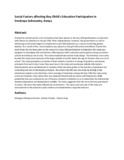| dc.contributor.author | Kisiangani, Munyasia Dorine | |
| dc.contributor.author | Buhere, Pamela | |
| dc.contributor.author | Antony, Sang | |
| dc.date.accessioned | 2021-12-20T04:59:46Z | |
| dc.date.available | 2021-12-20T04:59:46Z | |
| dc.date.issued | 2019-11 | |
| dc.identifier.uri | https://www.ijsr.net/archive/v8i11/ART20202591.pdf | |
| dc.identifier.uri | http://ir-library.mmust.ac.ke:8080/xmlui/handle/123456789/1869 | |
| dc.description.abstract | During Pre-colonial period a lot of emphasis had been placed to the boy child participation in education with almost no attention to the girl child. After independence, however, the government in a bid to addressing social justice begun to emphasize on girl child education as a way of promoting gender balance. As a result of this, more emphasis was placed on the girl child school enrollment. Due to this, much focus has not been given to the research on boy child participation in education this study was designed to investigate the social factors affecting boy child’s education participation among secondary schools in Emuhaya sub County. This study employed descriptive study design. The Emuhaya sub county formed the study areas because of the large number of youths below the age of 18 years who are out of school. The study population consisted of both students, teachers in charge of guidance and deputy principals from each school since they were key to the study and would give reliable information. Questionnaires were administered to students while interview guides to the teachers of guidance and counseling and also to the deputy principals. Document checklist was also done by looking at the attendance registers and obtaining a mean average of absentees among the boy child thus measuring school participation. Descriptive data was analyzed thematically by means and frequencies while qualitative data was analyzed by use of Pearson moment correlation so as to determine the relationship between dependent and independent variable. The study suggested that the more the boys got absent in school, the more they were affected by social factors. The views and outcome of the study are instrumental to the education policy makers and implementers of gender balance. | en_US |
| dc.language.iso | en | en_US |
| dc.publisher | International Journal of Science and Research (IJSR | en_US |
| dc.subject | Social, Factors, affecting, Boy, Child’s, Education, Participation | en_US |
| dc.title | Social Factors Affecting Boy Child’s Education Participating in Emuhaya Sub County, Kenya | en_US |
| dc.type | Article | en_US |

